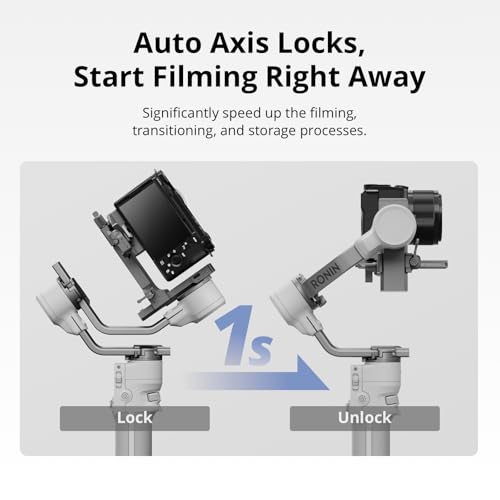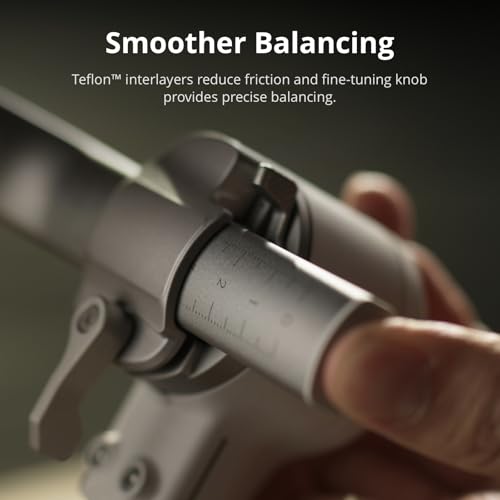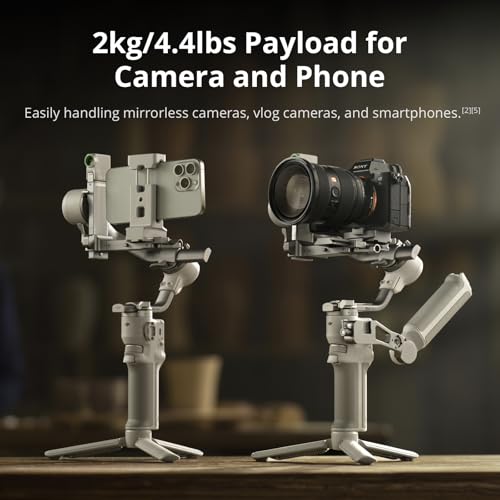The Apex of Agility: A Technical Deep Dive into the DJI RS 4 Mini Combo Gimbal Stabilizer
Introduction: Redefining “Run-and-Gun” Cinematography
In the world of modern videography, speed and agility are paramount. The rise of lightweight, full-frame mirrorless cameras has empowered solo creators and small crews to produce stunning cinematic content, but this freedom has always been tethered to the challenge of stabilization. For years, filmmakers have faced a compromise: carry a heavy, cumbersome gimbal for perfect stability, or sacrifice smoothness for portability. DJI, a name synonymous with stabilization technology, has relentlessly pursued a solution to this dilemma. The DJI RS 4 Mini Combo is the emphatic result of that pursuit. This is not just a smaller version of its predecessors; it is a ground-up redesign, a purpose-built tool engineered for the fast-paced, versatile demands of today’s content creator. It represents the perfect synthesis of power, intelligence, and unprecedented portability.
This technical review will dissect the engineering and performance of the DJI RS 4 Mini, with a specific focus on the enhanced capabilities unlocked by the Combo package. We will move beyond the marketing claims to analyze the real-world impact of features like the second-generation auto axis locks, the Teflon-enhanced balancing system, and the game-changing native vertical shooting mode. We’ll benchmark its 2kg payload capacity against popular camera and lens combinations and explore how the included RS Intelligent Tracking Module transforms this camera stabilizer into a standalone robotic camera operator. For the event videographer, the travel filmmaker, the vlogger, and the social media content creator who demand both cinematic quality and operational efficiency, this analysis will determine if the DJI RS 4 Mini Combo is truly the new indispensable tool for agile filmmaking.

In-Depth Technical Feature Analysis
The DJI RS 4 Mini is a dense package of innovative technologies. Each feature is designed not just for performance, but for speed and efficiency on set. Let’s explore the core engineering that sets this gimbal stabilizer apart.
1. “Ready in 1 Second”: The Evolution of Auto Axis Locks
One of the most significant workflow enhancements is the second-generation implementation of auto axis locks. On previous gimbals, locking and unlocking the three axes (pan, tilt, and roll) was a manual, multi-step process. This added crucial seconds, or even minutes, to setup and breakdown times—time that can be the difference between capturing a fleeting moment and missing it entirely. The RS 4 Mini automates this process entirely. When the gimbal is powered off, the axes automatically lock into a secure, compact position for transport. The moment you press the power button, they unlock simultaneously, ready for balancing and operation in about a second. This is a monumental quality-of-life improvement. It eliminates the fumbling associated with manual locks, streamlines transitions between shots, and ensures the gimbal is always ready for immediate deployment. For documentary and event shooters, this feature alone is a compelling reason to upgrade.

2. Power in a Small Package: 2kg/4.4lbs Payload and Motor Performance
Despite its “Mini” designation, the RS 4 Mini is equipped with powerful, high-torque motors capable of supporting a payload of up to 2 kg (4.4 lbs). This payload capacity is a critical specification, as it determines which camera and lens combinations the gimbal can effectively stabilize. The 2kg limit is a sweet spot, perfectly accommodating the vast majority of popular full-frame and APS-C mirrorless setups used by modern creators. This includes workhorse combinations like:
- Sony Alpha series (A7S III, A7 IV, FX3) with compact G-Master prime or G series zoom lenses.
- Canon EOS R series (R5, R6, R8) with lightweight RF prime or standard zoom lenses.
- Fujifilm X-series (X-H2S, X-T5) with their range of high-quality XF lenses.
- Panasonic Lumix S5II with compact L-mount primes.
The power of the motors, combined with DJI’s 4th-generation stabilization algorithm, ensures that even at the upper end of this payload range, the gimbal can handle aggressive movements, fast pans, and quick tilts without motor strain or micro-jitters, delivering consistently smooth and stable footage.
3. Precision Engineering: Teflon-Enhanced Balancing
Balancing a gimbal is an art of precision. Even a slight imbalance can cause motor strain, reduce battery life, and introduce vibrations into the footage. The DJI RS 4 Mini introduces a subtle but significant innovation to this process: Teflon coating on all three axes. Teflon is known for its extremely low coefficient of friction. By applying this coating to the sliding arms of the gimbal, DJI has made the balancing process noticeably smoother and more precise. The camera platform glides along the axes with less resistance, allowing for finer, more granular micro-adjustments. This means you can achieve a perfect balance faster and with less frustration, a detail that experienced gimbal operators will immediately recognize and appreciate during fast-paced shoots where quick lens changes are required.

4. Native Vertical Shooting: A Game-Changer for Modern Content
In today’s multi-platform media landscape, the ability to create high-quality vertical content is no longer optional. The DJI RS 4 Mini addresses this with a groundbreaking fast vertical switch mechanism. Traditionally, shooting vertical video on a gimbal required either awkward L-brackets that compromised balance or tilting the camera 90 degrees, which shifted the center of gravity and limited movement. The RS 4 Mini features a newly designed, two-part quick-release plate. Without any additional accessories, you can detach the horizontal plate, and mount it directly to the vertical arm of the gimbal in under 10 seconds. This provides true, native vertical stabilization. The camera remains perfectly balanced on its central axis, allowing for the full range of motion and stabilization performance in a 9:16 format. This is an essential feature for creating professional-looking content for platforms like Instagram Reels, TikTok, and YouTube Shorts, allowing creators to switch formats on the fly.

5. Unmatched Responsiveness and Control
The core of any gimbal is its ability to translate operator intent into smooth camera movement. The RS 4 Mini excels with its advanced algorithm and customizable follow modes. The new Responsive Follow Mode is specifically tuned for speed and immediacy. It minimizes the smoothing and latency found in more cinematic modes, making the gimbal react almost instantly to the operator’s hand movements. This is ideal for fast-paced scenarios, such as tracking an athlete or performing a rapid whip-pan, where the camera needs to keep up with unpredictable action. The full-color touchscreen provides intuitive access to all modes, including Pan Follow, Pan and Tilt Follow (PTF), and FPV, allowing the operator to tailor the gimbal’s behavior to the specific needs of the shot.

The Combo Advantage: Unlocking Intelligent Features
While the standalone RS 4 Mini is a formidable tool, the Combo package elevates it to another level by adding two crucial components that unlock its full intelligent potential and enhance its ergonomic flexibility.
- RS Intelligent Tracking Module: This is the star of the combo. This small, external module attaches to the gimbal and gives it the power of DJI’s renowned ActiveTrack technology, completely independent of a smartphone. Using its own built-in camera and processor, the module allows you to select a subject, and the gimbal will automatically pan and tilt to keep that subject perfectly framed. This is a revolutionary tool for solo creators, effectively turning the gimbal into a personal robotic camera operator. You can set the gimbal on a tripod and have it track you as you present to the camera, perform a task, or move around a space.
- Briefcase Handle: This ergonomic handle attaches to the base of the gimbal, allowing it to be held in a low-slung briefcase mode. This is the most comfortable and stable way to achieve smooth, low-angle tracking shots. It significantly reduces wrist and arm strain compared to holding the gimbal in a traditional inverted mode, allowing for longer, more complex shots at ground level.

Pros: Key Performance Strengths
- Unmatched Portability: Exceptionally lightweight and compact design makes it the ideal gimbal for travel, vlogging, and run-and-gun shoots.
- Incredibly Fast Workflow: The combination of auto axis locks and Teflon-coated axes makes setup, balancing, and breakdown significantly faster than previous models.
- True Native Vertical Shooting: The innovative quick-release plate design allows for fast switching to a fully-stabilized vertical mode, essential for social media content.
- Powerful Standalone Tracking (Combo): The RS Intelligent Tracking Module provides robust subject tracking without needing to connect a phone, a huge advantage for solo operators.
- Excellent Stabilization Performance: The 4th-generation algorithm and strong motors deliver consistently smooth footage across a wide range of movements.
- Great Value Combo Package: The inclusion of the tracking module and briefcase handle in the combo offers professional-level features at an accessible price point.
Conclusion: The New Standard for Lightweight Camera Stabilization
The DJI RS 4 Mini Combo is a masterstroke of design and engineering. It is far more than just a small gimbal; it is a complete, intelligent stabilization ecosystem that has been fine-tuned for the express purpose of speed, portability, and creative freedom. DJI has listened intently to the needs of modern creators and has delivered a product that addresses their biggest pain points. The ridiculously fast setup time, the effortless switch to native vertical shooting, and the powerful standalone subject tracking are not just features—they are workflow revolutions.
For the solo filmmaker, the travel content creator, the wedding videographer, or the social media professional, the RS 4 Mini Combo is a near-perfect tool. It provides the rock-solid stability expected from the DJI RS line in a package that you’ll actually want to carry with you. It removes technical friction at every turn, allowing you to stay in the creative flow and focus on capturing the shot. While it may not have the payload for heavy cinema rigs, it has mastered its domain: the world of mirrorless cameras. The DJI RS 4 Mini Combo is, without question, the new benchmark for lightweight, intelligent camera stabilization, and an essential piece of kit for any serious modern videographer.








